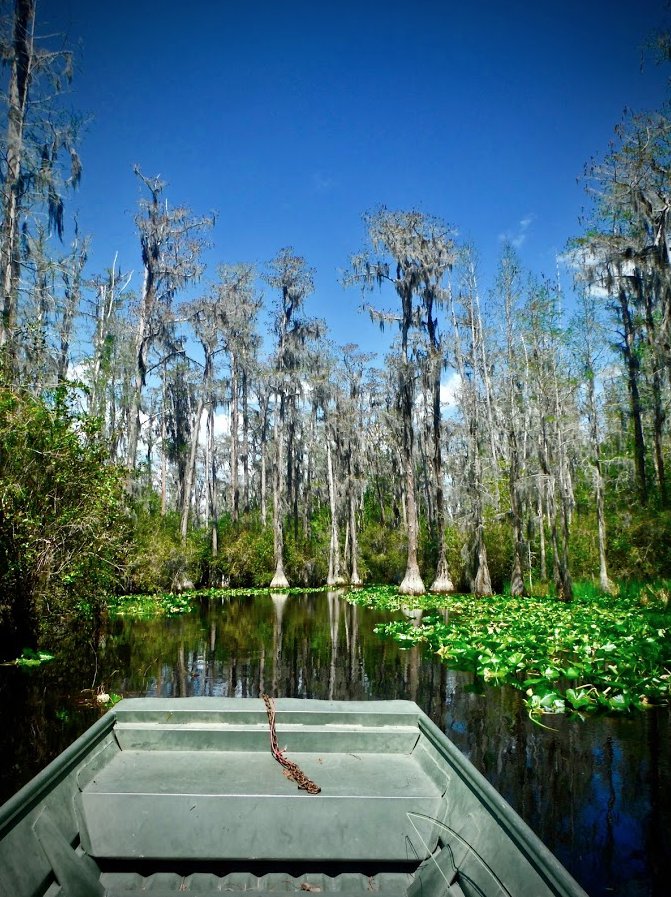By Chris Hunt
The first time I visited a blackwater swamp, I was probably about 12. My dad rented a little jon boat from the marina near Uncertain, Texas, and he manned the tiller as we glided over the glassy waters of Caddo Lake. I was instantly enchanted.
At the time, 35 years ago, East Texas was in the latter throes of an oil boom that would go bust just a few years later. We’d moved down South from Colorado after my dad took a management job with a drilling company, and we were enjoying the largesse that came with high oil prices—we had a pool in the backyard and my brothers and I were learning to water ski. We fished in every damp spot we could find, and there were lots of them in the piney woods. It was a great time, and a great place, to be a kid.
And then we visited Caddo, which straddles the border of Texas and Louisiana, and was the backdrop for the film Southern Comfort, a creepy flick about a National Guard unit that runs into some backwoods Cajun locals in a stereotypical Lousiana swamp setting. The lake is the idyllic blackwater swamp, adorned with cypress trees and lined by live oaks, all draped in Spanish moss that blows quietly in the soft southern breezes. Parts of the lake are just channels carved through the swamp—wide enough through which to paddle a canoe or steer a jon boat, but not much else.
At every turn, it seemed, something would spring from the water. Great blue herons, egrets, ibis and a host of marsh-loving birds stood in the shallows, harvesting everything from small fish to tadpoles. We watched one afternoon as a heron stalked a baby alligator and plucked it from the lily pads. The reptile squirmed helplessly in the beak of the giant bird, and my brothers and I were thrilled at the up-close scene that we might only have seen on some Mutual of Omaha Wild Kingdom episode if we hadn’t been floating quietly along in the swamp.
I returned to Caddo often in my youth, fishing for its bass, catfish and crappie and generally pulling the wild energy from it at every opportunity. In a place where public lands are nearly non-existent, Caddo was an oasis that seemingly belonged to everyone—it was a place where we could launch a canoe and not have to tell a soul what we were were up to. And it was legitimately wild, complete with gators and gar, and snakes and snapping turtles. In the open portion of the lake, I’ve glided across the water on skis. Back in the swamp? No thank you. Hands and arms inside the vehicle at all times, please.
My affinity for blackwater swamps started during those formative years, and as I ventured throughout the South in my teens, I began to really appreciate these oases in the midst of all the southern development. The few blackwater basins that remain have likely survived efforts to drain them, log them or otherwise alter them entirely. That some hang on today is nothing short of miraculous.
I’m headed down to fish the blackwater Okefenokee Swamp next week, a place where gators outnumber tourists every day of the year, and one of the last truly wild low spots in the South that hasn’t been totally destroyed. Today, it’s a national wildlife refuge, as it should be, and it’s home to most indigenous southern wildlife, from gators to black bears and otters to toothy long-nose gar.
And, my favorite southern fish, bowfin, or mudfish, as the locals call them, swim among the cypress. This prehistoric fish navigated the black waters of the South when dinosaurs walked the earth, and now, it’ll hit flies and entertain a visiting angler from the mountains. I’ll pull from some of Okefenokee’s wild energy while I’m there and I’ll revel in the soft, warm, southern breezes as the last of winter blows through the mountains back home.
It’ll be like being a kid again, paddling over black water and mysteries that lie beneath. And I’ll be enchanted once more.
Chris Hunt is the national digital director for TROUT Media. He lives and works in Idaho Falls.



